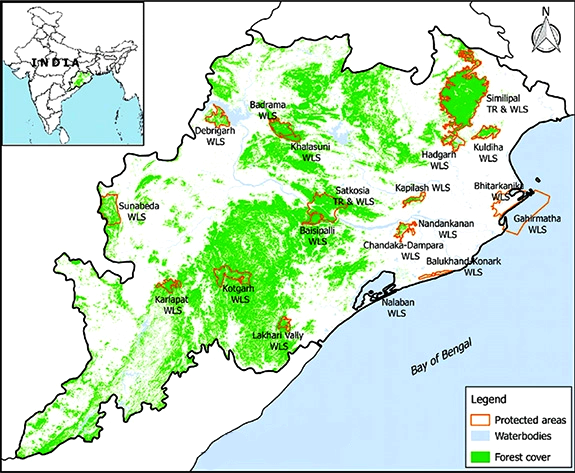Important Facts For Prelims
Similipal Biosphere Reserve: Odisha
- 23 Feb 2022
- 3 min read
Why in News?
Recently the Forest Administration and SHGs (Self Help Groups) have started an awareness Campaign to manage fires in Similipal Biosphere Reserve this year.
- Earlier, scientists unravelled the mystery behind Odisha’s ‘Black Tigers’ in Similipal Tiger Reserve (STR).
What are the Key Points?
- About:
- Similipal derives its name from ‘Simul’ (silk cotton) tree.
- It was formally designated a tiger reserve in 1956 and brought under Project Tiger in the year 1973.
- It was declared a biosphere reserve by the Government of India in June, 1994.
- It has been part of the UNESCO World Network of Biosphere Reserve since 2009.
- It is part of the Similipal-Kuldiha-Hadgarh Elephant Reserve popularly known as Mayurbhanj Elephant Reserve.
- It is prone to forest fires. In 2021, the Simlipal saw a major fire between February-end and early March.
- Location:
- It is situated in the northern part of Odisha’s Mayurbhanj district. Geographically, it lies in the eastern end of the eastern ghat.
- Coverage:
- The biosphere spread over 4,374 sq. km. has 845 sq. km. of core forest (tiger reserve), 2,129 sq km buffer area and 1,400 sq km of transition space.
- Vegetation:
- Similipal has 1,076 flowering species and 96 species of orchids.
- It boasts of having tropical semi-evergreen forests, tropical moist deciduous forests, dry deciduous hill forests.
- Tribes:
- Two tribes, the Erenga Kharias and the Mankirdias, inhabit the reserve’s forests and practise traditional agricultural activities.
- Wildlife:
- Similipal is home to a wide range of wild animals including tigers and elephants, besides 304 species of birds, 20 species of amphibians and 62 species of reptiles.
What causes Fires and MItigation?
- Forest Fires:
- Natural: Natural causes such as lighting or even soaring temperatures can sometimes result in forest fires here.
- Man Made Factors: Instances of poaching and hunting wherein the poachers set a small patch of forest on fire to divert the wild animals.
- Mitigation Strategies:
- Forecasting fire-prone days and including community members to mitigate incidents of fire, creating fire lines, clearing sites of dried biomass, and crackdown on poachers.
What are the Other Major Protected Areas in Odisha? 
- Bhitarkanika National Park
- Badrama WLS
- Chilika (Nalaban island) WLS
- Hadgarh WLS
- Baisipalli WLS
- Kotagarh WLS
- Nandankanan WLS
- Lakhari Valley WLS
- Gahirmatha (Marine) WLS






